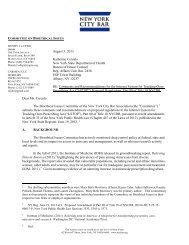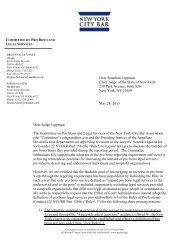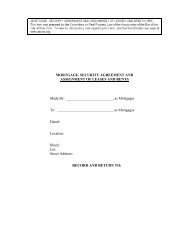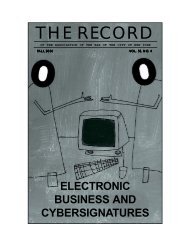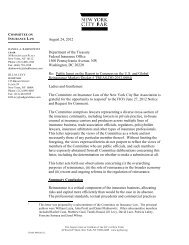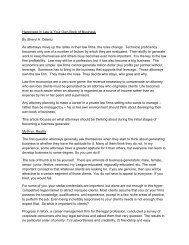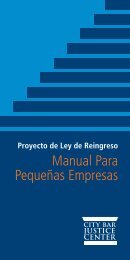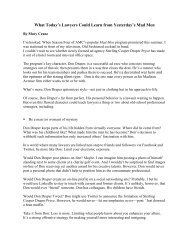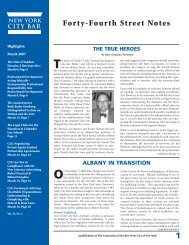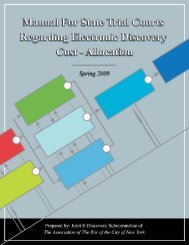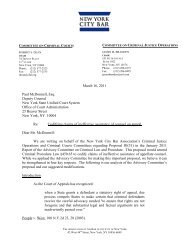2007 Issue 1 - New York City Bar Association
2007 Issue 1 - New York City Bar Association
2007 Issue 1 - New York City Bar Association
Create successful ePaper yourself
Turn your PDF publications into a flip-book with our unique Google optimized e-Paper software.
C I V I L R I G H T S, I N F O R M A T I O N T E C H N O L O G Y L A W,<br />
L E G A L I S S U E S A F F E C T I N G P E O P L E W I T H D I S A B I L I T I E S<br />
To the contrary, when discussing public accommodations, Congress<br />
spoke in expansive—not restrictive—terms. Thus, in the final list<br />
of twelve categories of entities, Title III lists a few examples, then adds<br />
“other place of lodging . . . other place of public gathering . . . other sales<br />
or rental establishment.” As the House Committee Report on the ADA<br />
points out, this ensures that a person alleging discrimination need not<br />
prove the discriminating entity is similar to one of the listed examples.<br />
“Rather, the person must show that the entity falls within the overall<br />
category. For example, it is not necessary to show that a jewelry store is<br />
like a clothing store. It is sufficient that the jewelry store sells items to<br />
the public.” 18 Thus, the key attribute of the public accommodation is the<br />
act of selling to the public, not the nature of the location where it does<br />
the selling. 19<br />
Furthermore, a Website is a “facility,” as defined by the DOJ regulations<br />
promulgated at the direction of the ADA. 20 A “facility” includes “all<br />
or any portion of . . . sites, . . . equipment, . . . or other . . . personal<br />
property . . .” of the public accommodation. 21 Under this definition, a<br />
Website clearly has a “site”—a physical location on “equipment” such as<br />
a server. People enter this “site” using remote computers, accessing “goods,<br />
services, facilities, privileges, advantages, or accommodations” 22 resident<br />
18. H.R. Rep. No. 101-485, pt. 3, at 54 (1990), reprinted in 1990 U.S.C.C.A.N. 445, 447.<br />
19. See Doe v. Mutual of Omaha Ins. Co., 179 F.3d 557, 562 (7 th Cir. 1999) (Posner, J.) (“Both<br />
committee reports . . . give the example of refusing to sell an insurance policy to a blind<br />
person, as does the gloss placed . . . by the Department of Justice.”) (citing 28 C.F.R, Part 36,<br />
App. B § 36.212).<br />
20. 42 U.S.C. § 12186(b). Because they are expressly authorized by Congress, courts must<br />
give these regulations “legislative and hence controlling weight unless they are arbitrary,<br />
capricious, or plainly contrary to the statute.” United States v. Morton, 467 U.S. 822, 834<br />
(1984); Martin, 225 F. Supp. 2d at 1374.<br />
21. 28 C.F.R. § 36.104. That “site” is not limited to a plot of ground is emphasized by the<br />
continuing language of the definition: “including the site where the building, property, structure,<br />
or equipment is located.” The regulations further demonstrate that prohibitions against<br />
discrimination are not limited to a “place,” pointing out that a “health care provider” is a<br />
“public accommodation,” which must provide nondiscriminatory health care to people with<br />
or without disabilities: “A physician who specializes in treating only a particular condition<br />
cannot refuse to treat an individual with a disability for that condition, but is not required to<br />
treat the individual for a different condition.” 28 C.F.R. § 36.202(b)(2). The same could be<br />
said of an “establishment” providing legal or other services, whether operating in a firm,<br />
office or from home. See supra n. 17, discussing 42 U.S.C. § 12181(7). There is no physical<br />
space “trigger” that activates the prohibition against discrimination.<br />
22. 42 U.S.C. § 12181(1).<br />
T H E R E C O R D<br />
124



